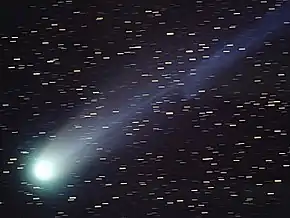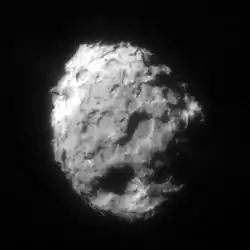8P/Tuttle
8P/Tuttle (also known as Tuttle's Comet or Comet Tuttle) is a periodic comet with a 13-year orbit. It fits the classical definition of a Jupiter-family comet with an orbital period of less than 20 years, but does not fit the modern definition of (2 < TJupiter< 3).[2] The next perihelion passage is August 27, 2021 when the comet will have a solar elongation of 26 degrees at approximately apparent magnitude 9.[5] Closest approach to Earth will be a rather distant 1.8 AU (270 million km) on September 12, 2021 which is about as far from Earth as the comet can get when the comet is near perihelion.
 | |
| Discovery | |
|---|---|
| Discovered by | Horace Parnell Tuttle |
| Discovery date | January 5, 1858 |
| Alternative designations | 1790 II; 1858 I; 1871 III; 1885 IV; 1899 III; 1912 IV; 1926 IV; 1939 X; 1967 V; 1980 XIII; 1994 XV |
| Orbital characteristics A | |
| Epoch | January 15, 2008 |
| Aphelion | 10.376340 AU |
| Perihelion | 1.027132 AU |
| Semi-major axis | 5.701737 AU |
| Eccentricity | 0.819856 |
| Orbital period | 13.6 a[1] |
| Inclination | 54.9830° |
| Earth MOID | 0.095 AU (14.2 million km)[2] |
| Dimensions | 4.5 km contact binary[2] |
| Last perihelion | January 27, 2008 |
| Next perihelion | August 27, 2021[3][4] |
Comet 8P/Tuttle is responsible for the Ursid meteor shower in late December.[6]
2008 perihelion
Under dark skies the comet was a naked eye object. Perihelion was late January 2008, and as of February was visible telescopically to Southern Hemisphere observers in the constellation Eridanus. On December 30, 2007 it was in close conjunction with spiral galaxy M33. On January 1, 2008 it passed Earth at a distance of 0.25282 AU (37,821,000 km; 23,501,000 mi).[2]
Predictions that the 2007 Ursid meteor shower could be expected to be stronger than usual due to the return of the comet,[7] did not appear to materialize, as counts were in the range of normal distribution.
Contact binary
Radar observations of Comet Tuttle in January 2008 by the Arecibo Observatory show it to be a contact binary.[8][9] The comet nucleus is estimated at about 4.5 km in diameter, using the equivalent diameter of a sphere having a volume equal to the sum of a 3 km and 4 km sphere.[2]
Additional images

Sun · Venus · Earth · Mars · Jupiter · Saturn · C/2018 V1
 Tuttle on December 3, 2007 from Mount Laguna, California
Tuttle on December 3, 2007 from Mount Laguna, California About 1.2 degrees from M33 on December 30, 2007.
About 1.2 degrees from M33 on December 30, 2007.
References
- Ley, Willy (September 1968). "Mission to a Comet". For Your Information. Galaxy Science Fiction. pp. 101–110.
- "JPL Small-Body Database Browser: 8P/Tuttle". NASA/Jet Propulsion Laboratory. June 6, 2008. Retrieved February 25, 2010.
- "8P/Tuttle Orbit". Minor Planet Center. Retrieved January 13, 2021.
- Kinoshita, Kazuo (January 24, 2008). "8P/Tuttle". Comet Orbits.
- Seiichi Yoshida (June 28, 2020). "8P/Tuttle". Seiichi Yoshida's Comet Catalog. Retrieved July 20, 2020.
- "Meteor Streams". NASA.gov. Retrieved July 28, 2014.
- Jenniskens, P.; Lyytinen, E.; Nissinen, M.; Yrjölä, I.; Vaubaillon, J. (December 2007). "Strong Ursid shower predicted for 2007 December 22" (PDF). WGN, Journal of the International Meteor Organization. 35 (6): 125–133. Bibcode:2007JIMO...35..125J.
- Schilling, Govert (October 14, 2008). "Comet Tuttle's Split Personality". Science. Retrieved October 25, 2008.
- Harmon, J. K.; Nolan, M. C.; Howell, E. S.; Giorgini, J. D. (2008). Comet 8P/Tuttle: Arecibo Radar Observations of the First Bilobate Comet (PDF). 10th Asteroids, Comets, Meteors. 13–18 July 2008. Baltimore, Maryland. Lunar and Planetary Institute.
External links
- Orbital simulation from JPL (Java) / Horizons Ephemeris
- 8P/Tuttle – Seiichi Yoshida @ aerith.net
- 8P at Kronk's Cometography
- 8P/Tuttle time sequence
- Comet Tuttle Seen To Be Returning
- Comet 8P/Tuttle. Canary Islands, Tenerife. 06.01.2008
- NASA Orbital Diagram
| Numbered comets | ||
|---|---|---|
| Previous 7P/Pons–Winnecke |
8P/Tuttle | Next 9P/Tempel |

